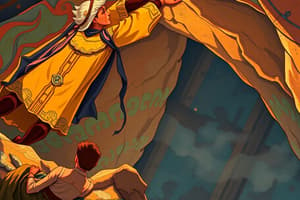Podcast
Questions and Answers
What is composition?
What is composition?
The organization or arrangement of visual elements, such as lines, spaces, tones, and colors, in a work of art.
What is still life?
What is still life?
An arrangement of stationary objects that are subject matter for a work of art.
What is the picture plane?
What is the picture plane?
The actual two-dimensional, flat surface on which a drawing is made.
What does variety refer to in art?
What does variety refer to in art?
What is emphasis in art?
What is emphasis in art?
What is unity in design?
What is unity in design?
What is a contour line?
What is a contour line?
What is an implied line?
What is an implied line?
What does figure ground mean?
What does figure ground mean?
What is a hard edge in art?
What is a hard edge in art?
What is a cast shadow?
What is a cast shadow?
What is a drawing style?
What is a drawing style?
What does overlapping mean in art?
What does overlapping mean in art?
What are working drawings?
What are working drawings?
Flashcards are hidden until you start studying
Study Notes
Vocabulary for Art Studies
-
Composition: The arrangement of visual elements, including lines, spaces, tones, and colors, essential for creating a cohesive artwork.
-
Still Life: A specific genre featuring an arrangement of stationary objects, serving as the subject matter for artistic expression.
-
Picture Plane: The flat, two-dimensional surface on which drawings are created, acting as the boundary of visual space.
-
Variety: The use of diverse elements in a composition, contributing to visual interest and complexity.
-
Emphasis: An artistic principle that employs contrasting shapes and colors to draw attention to focal areas within a work.
-
Unity: A design principle that integrates various elements to create a sense of wholeness and cohesion in artwork.
-
Contour Line: Lines that outline and define the edges of objects or figures, essential for creating form and structure.
-
Implied Line: A line that is not physically present but suggested through changes in color or value, guiding the viewer’s eye.
-
Figure Ground: Describes the relationship between the main subject (figure) and the background (ground) in an artwork, affecting perception.
-
Hard Edge: Characterized by sharp, clean lines and transitions, often achieved with flat, uniform colors or values.
-
Cast Shadow: The shadow created by an object that appears on a nearby surface, contributing to the sense of depth and dimension.
-
Drawing Style: A distinctive method of drawing or shading that embodies an artist's individual approach or a historical art period.
-
Overlapping: A technique where one object is placed in front of another to create a visual sense of depth and layers in the artwork.
-
Working Drawings: Also known as preliminary sketches, these are initial study drawings leading towards a final piece of art.
Studying That Suits You
Use AI to generate personalized quizzes and flashcards to suit your learning preferences.




